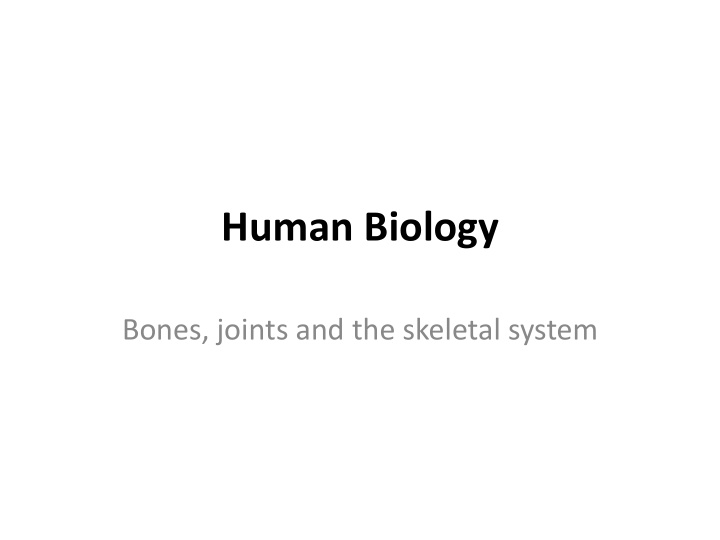



Human Biology Bones, joints and the skeletal system
• Classification and functions of skeletal cartilages. • Classification and functions of bones. • Bone structure. • Bone homeostasis: remodeling and repair. • An overview of the skeleton. • Axial skeleton: skull, vertebral column, thoracic cage. • Appendicular skeleton: pectoral (shoulder) girdle, upper limb, pelvic (hip) gridle, lower limb. • Classification and function of joints. • Fibrous joints. • Cartilaginous joints. • Synovial joints.
Classification and functions of skeletal cartilages Classification of Functions of skeletal cartilages skeletal cartilages • Hyaline cartilages (articular • Provide support with flexibility cartilages, costal cartilages, and resilience respiratory cartilages, nasal • Withstand both pressure and cartilages) tension well • Elastic cartilages (occur in the external ear and the epiglottis • Fibrocartilages (e.g. padlike cartilages (menisci) of the knee and the discs between vertebrae)
Growth of Cartilage appositional growth cartilage-forming cells interstitial growth secrete new matrix the lacunae-bound against the external chondrocytes divide face of the existing and secrete new cartilage tissue matrix, expanding the cartilage from within
Classification and functions of bones
Classification and functions of bones Functions of bones: • Support • Protection • Movement • Mineral and growth factor storage • Blood cell formation • Triglyceride (fat) storage • Hormone production (osteocalcin)
Chemical Composition of Bone Organic Components Inorganic Components cells (osteogenic cells, osteoblasts, consists of inorganic mineral salts, osteocytes, bone-lining cells, and largely calcium phosphates osteoclasts) osteoid , the organic part of the matrix. Osteoid includes ground substance (composed of proteoglycans and glycoproteins ) collagen fibers , both of which are made and secreted by osteoblasts.
Bone cells
Structure of Short, Irregular, and Flat Bones
Bone structure
A single osteon
Bone structure
Bone growth
Bone homeostasis: remodeling and repair Bone deposit Bone resorption
Bone homeostasis: remodeling and repair • Bone deposit and bone resorption occur at the surfaces of both the periosteum and the endosteum • Bone remodeling is coordnated by osteoblast and osteoclast • Bone deposit and bone resorption are balanced in healthy young adults
Bone deposit Factros trigger Calcification front calcification: Mineralized matrix Osteoid seam 10-12 um • Proper concentration of Unmineralized calcium and phosphate Produced by osteocytes ions • Presecne of alkaline phosphatase – enzyme essential for mineralization
Bone resorption Osteoclasts : Is accomplished by osteoclasts • Move along a bone surface • Dig groves • Break down the bone matrix • Possess highly folded membrane (this adaptaion increase area of bone resorption) • Secrete lysosomal enzymes - digest organic matrix • Secrete hydrochloric acid – convert calcium into soluble form
Hormonal control of bone remodeling
Control of remodeling Remodeling is affected by many factors: • Hormones: Parathyroid hormone (PTH) — Stimulates osteoclasts Calcitonin — Stimulates osteoblasts Human growth hormone (hGH) — Stimulates cartilage and bone growth Insulin-like growth factor (IGF) — Stimulates cartilage and bone growth Sex hormones — Sex-related differences in skeletal growth • Minerals — Availability of calcium, magnesium, and phosphorus • Vitamins A, C, and D • Activity level — Active versus sedentary lifestyle • Diet
Bone repair
Skull
The orbits
The nasal cavity The nasal septum and conchae are covered with a mucus- secreting mucosa that moistens and warms the entering air and helps cleanse it of debris. The scroll-shaped conchae increase the turbulence of air flowing through the nasal cavity. This swirling forces more of the inhaled air into contact with the warm, damp mucosa and encourages trapping of airborne particles (dust, pollen, bacteria) in the sticky mucus.
Paranasal sinuses Small openings connect the sinuses to the nasal cavity and act as “two - way streets”: Air enters the sinuses from the nasal cavity, and mucus formed by the sinus mucosae drains into the nasal cavity. The mucosa of the sinuses also helps to warm and humidify inspired air. The paranasal sinuses lighten the skull and enhance the resonance of the voice.
The hyoid bone Though not really part of the skull, the hyoid bone lies just inferior to the mandible in the anterior neck, and looks like a miniature version of it. The hyoid bone is unique in that it is the only bone of the body that does not articulate directly with any other bone. Instead, it is anchored by the narrow stylohyoid ligaments to the styloid processes of the temporal bones. Horseshoe-shaped, with a body and two pairs of horns, or cornua, the hyoid bone acts as a movable base for the tongue. Its body and greater horns are attachment points for neck muscles that raise and lower the larynx during swallowing and speech.
Vertebral column
The broad anterior ligament is strongly attached to both the bony vertebrae and the discs . prevents hyperextension of the spine The posterior ligament is narrow and relatively weak. It attaches only to the discs. It resists Ligamentum flavum connects adjacent vertebrae , hyperflexion of the Contains elastic connective tissue spine Is especially strong It stretches as we bend forward and then recoils when we resume an erect posture.
Thoracic cage
Classification and function of joints
Structural classyfication of joints • Fibrous – dens regular connective tissue holds together the ends of bones; no joint cavity • Cartilaginous – pad of cartilage is wedged between the ends of bones; no joint cavity • Synovial – ends of bones covered with articular cartilage; joint cavity separate the articulating bones; enclose by an articular capsule, lined by the synovial membrane; contains synovial fluid
Functional classyfication of joints • Synarthroses - which are immovable joints • Amphiarthroses - slightly movable joints • Diarthroses - freely movable joints
Fibrous joints
Cartilaginous Joints
Synovial joints
Recommend
More recommend